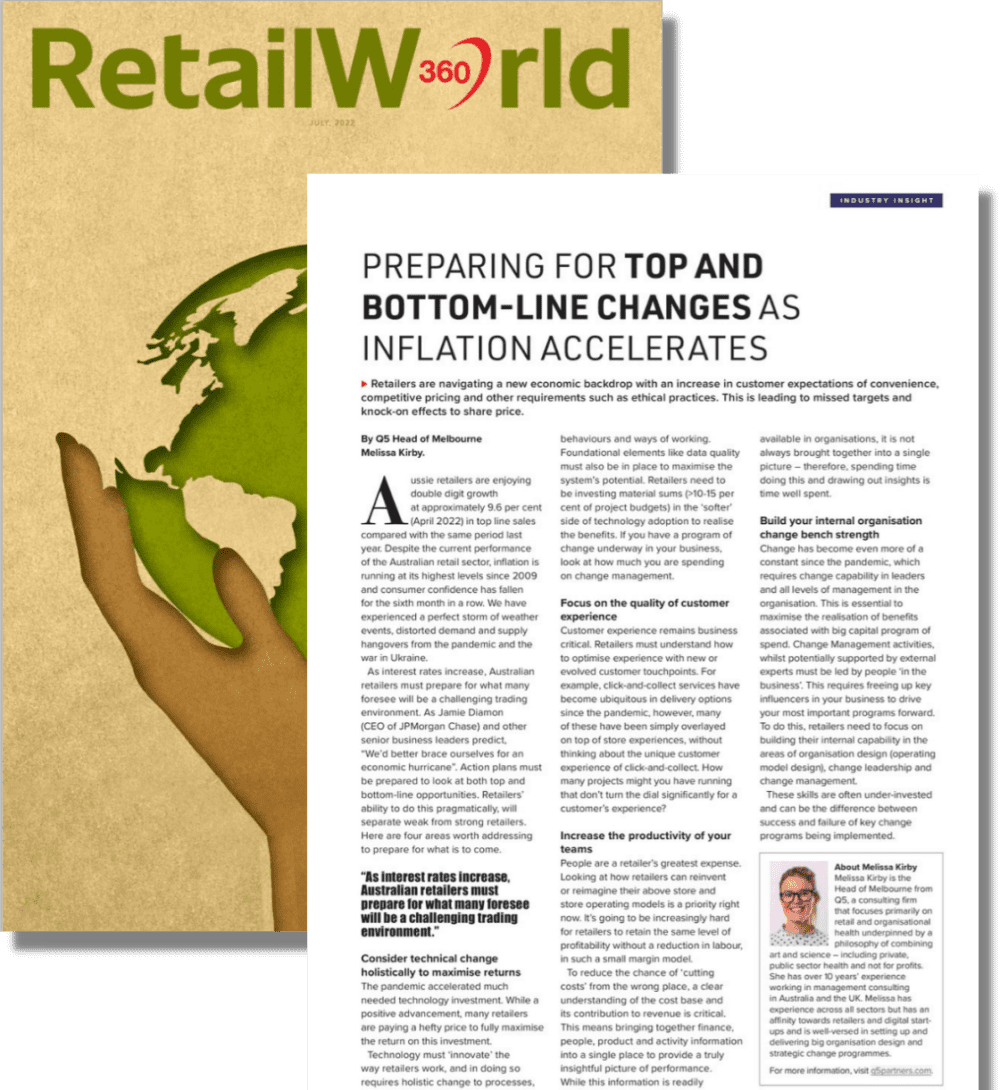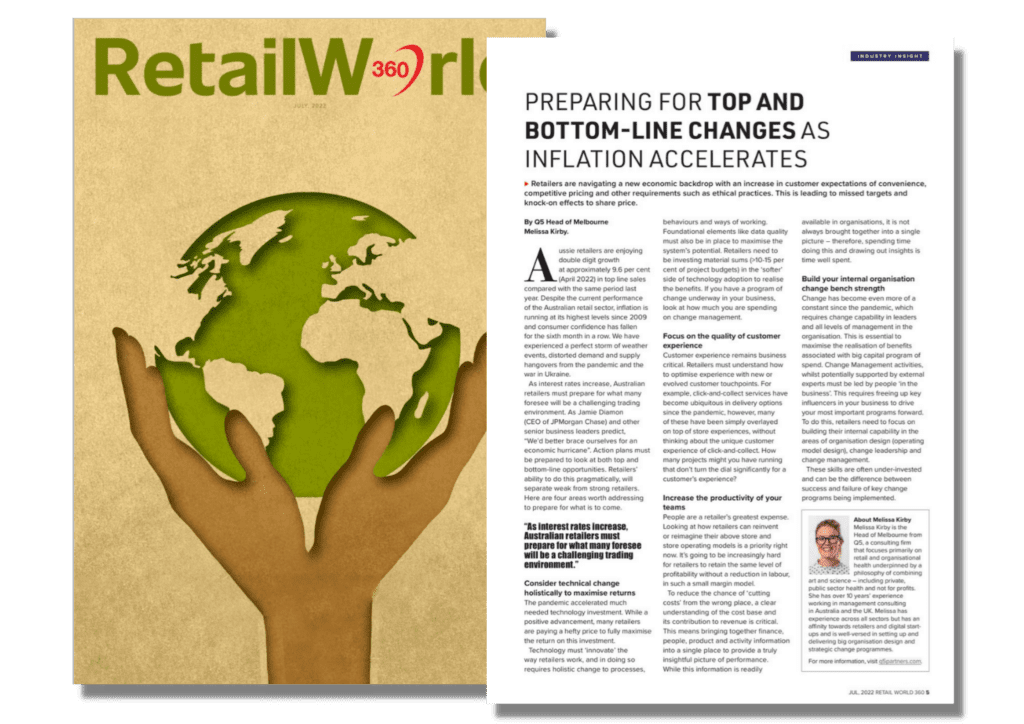
As seen on Retail World 360, July 2022 edition – access here

This article was originally published on Retail World.
https://retailworldmagazine.com.au/
Right now, Aussie retailers are enjoying double digit growth at approximately 9.6 percent (April 2022) in top line sales compared with the same period last year. This is in stark contrast with the US and UK markets with slowing growth and an expectation this will continue through 2022.
Cracks are starting to appear for some retailers, as we are seeing with well-known brands such as Kogan reporting excess inventory and Missguided going into administration last week. Retailers are navigating a new economic backdrop with an increase in customer expectations of convenience, competitive pricing and other requirements such as ethical practices. This is leading to missed targets and knock-on effects to share price.
We are also operating in an environment without the fiscal stimulus provided through the pandemic to both businesses and consumers.
Despite the current performance of the Australian retail sector, inflation is running at its highest levels since 2009 and consumer confidence has fallen for the sixth month in a row. We have experienced a perfect storm of weather events, distorted demand and supply hangovers from the pandemic and the war in Ukraine. Some retailers are now in a heavy discount / clearance model due to lagging supply catching up with demand, resulting in a build-up of excess inventory. Agile demand planning and forecasting processes are going to separate weak from strong retailers in the next half.
As interest rates increase, Australian retailers will be preparing for what many predict will be a challenging economical trading environment. As Jamie Diamon (CEO of JPMorgan Chase) and other senior business leaders predict, “We’d better brace ourselves for an economic hurricane”. Action plans must be prepared urgently to improve the options available to Board and Exec Teams. These plans must look at both top and bottom-line opportunities.
The pandemic has already accelerated much needed technology investment, largely through necessity, more so than choice. This is a good thing. However, many retailers are paying a hefty price to fully maximise the return on this investment. Foundational aspects of online, such as building a single source of high quality, multi-faceted product data is critical to get the most out of sophisticated fulfillment systems.
The balance must be struck between technology ‘innovating’ the way that retailers work versus making the technology work in the business. Organisations need to think about technological change holistically ensuring the organisation’s processes and data quality are considered alongside these changes. Retailers need to be investing material sums (>10-15% of project budgets) in the ‘softer’ side of technology change to realise the benefits. If you have a program of change underway in your business, look at how much you are spending on change management, and within this, how much of it is dedicated towards people-related changes versus system-related changes.
Customer experience is still critically important. Retailers need to understand how to integrate the experience that sits around touchpoints with the customer. In this new environment customers have choice and will vote with their feet. For example, Click&Collect services have become ubiquitous amongst customer delivery options, however, many of these have been simply overlayed on top of store experiences leading to a confused channel experience. Each channel needs to be considered ‘in its own right’ as well as how it seamlessly interacts with other channels that exist. Focusing on the customer journey also allows you to prioritise the internal programs you have running, ensuring the greatest impact in the most needed areas of the customer journey.
How many projects might you have running that don’t turn the dial significantly for a customer’s experience?
People are typically a retailer’s greatest expense, and with Labour already promised a 5.1 percent increase in the minimum wage, this looks set to increase. Looking at how retailers can reinvent or reimagine their above store and store operating models, is a priority right now. It’s going to be increasingly hard for retailers to retain the same level of profitability without a reduction in labour, in such a small margin model.
We see a myriad of initiatives looking to reimagine the use of labour in value chains, for example Coles have been introducing trolley-assisted check-outs to improve customer experience, and redirect Team Member effort to value-add activity elsewhere.
To understand where to start and to reduce the chance of ‘cutting costs’ from the wrong place, having a clear understanding of the cost base and its contribution to revenue is critically important. This means bringing together finance, people, product and activity information into a single place do provide a truly insightful picture of performance.
This view – the ‘true economics’ of the business is typically not provided by Enterprise Resource Planning (ERP) systems for two key reasons. Firstly, management information is often located in a siloed manner and not brought together to drive insight. Secondly, the way information is structured and the quality of it rarely allows decision making to take place with confidence.
We are approaching a period where changes are going to need to be led from the top of the business and implemented by senior teams alongside business-as-usual activity. This is essential to maximise the realisation of benefits associated with big capital program of spend. These activities, whilst potentially supported by external experts must be led by people ‘in the business’. This means freeing up key influencers in your business to drive your most important programs forward. To do this, retailers need to focus on building their internal capability in the areas of organisation design (operating model design), change leadership and change management.
These skills are often under-invested and can be the difference between success and failure of key change programs being implemented.
 Melissa is Head of Melbourne at Q5 Australia. She has over 10 years’ experience working in management and psychology consulting in Australia and the UK. She has experience across all sectors but has an affinity towards retailers and digital start-ups and is well versed in setting up and delivering big organization design and strategic change problems.
Melissa is Head of Melbourne at Q5 Australia. She has over 10 years’ experience working in management and psychology consulting in Australia and the UK. She has experience across all sectors but has an affinity towards retailers and digital start-ups and is well versed in setting up and delivering big organization design and strategic change problems.